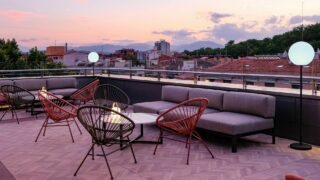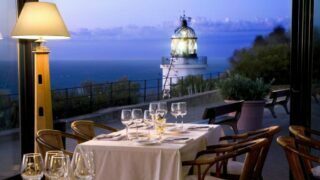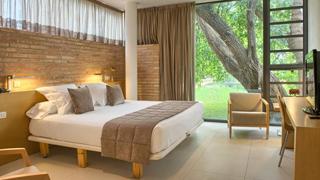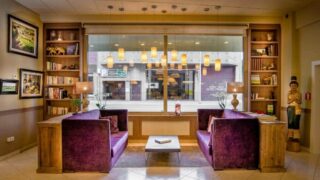
We’d love to see pictures and videos from your fabulous cycle tour through Spain!
Give us a follow on Instagram and tag us in your photos: @bikespaintours
Please leave your luggage in the hotel reception each morning (by 9am at the latest) so that it can be transferred to your next hotel. Make sure that your luggage is clearly labelled with the nametag provided. In case of any issues with the luggage transfer, please call Jacotrans on (+34) 606 049 858.
Your bike fitting is scheduled for Saturday, April 26 at 10am at Kyclos Bike Shop. In case of any issue please contact Juan at +34 679 80 99 28
Call the Bike Spain Tours office on +34 915 590 653, or out of office hours call +34 677 356 586. We will get you where you need to be and get you the help you need.
Please be aware that Spaniards follow a very particular routine in terms of their daily meals, and this is often strictly enforced by restaurant opening hours, especially in small towns!
You can expect restaurants to be open for lunch from approximately 1:30pm – 4pm. Many places will offer a menú del día: a set menu with 2/3 options for each course, usually including a drink, bread and dessert or coffee. Remember that lunch is the main meal of the day in Spain.
Dinnertime in Spain is any time from 8pm onwards. Dinner in Spain is typically a lighter meal.
Tuesday, 5th March: Girona
Arrival Day
Accommodation: Hotel Gran Ultonia [wp-svg-icons icon=”star-3″ wrap=”span”
Welcome to Catalonia, and the start of an amazing tour!
You can check into your hotel from 2pm. Please request your trip documentation from hotel reception upon arrival.
Enjoy some free time exploring the beautiful city of Girona: the colourful houses that line the River Onyar, the views from the medieval city walls and the atmosphere of one of the best-preserved Jewish Quarters in the world.
At leisure in Girona
Eating and drinking in Girona
Wednesday, 6th March: Girona – Sant Feliu de Guíxols
Route: 42.9 km/26.6 miles
Elevation: +276 m/+906 ft
Accommodation: Hotel S’Agaró Spa
Please leave your luggage in the hotel reception each morning (around 9am) so that it can be transferred to your next hotel.
9:30am: Please head to the offices of our local partners, CycleTours Catalonia (C. de Sta. Eugènia, 11), for your bike fitting.
Next, it’s time to start cycling! Your route follow a cycle path out of the city of Girona, heading south towards the Mediterranean Sea. This section follows a greenway called “El Carrilet”, passing through the towns of Quart, Cassà de la Selva, Llagostera and Santa Cristina d’Aro. Along the way, you can enjoy views of the Gavarres Massif, a mountainous forest area consisting mainly of cork oaks, making it an important area for cork production. The day’s ride ends in Sant Feliu de Guíxols, where you will stay near the charming Sant Pol beach.
At leisure in Sant Feliu de Guíxols
Eating and drinking in Sant Feliu de Guíxols
Day 3: Sant Feliu de Guíxols – Llafranc
Route: 33 km/20.5 miles
Elevation: +428 m/+1405 ft
Accommodation: Hotel El Far
Today’s route takes you north along the coast, combining the coastal road with seafront boulevards and enjoying fabulous views over the Mediterranean Sea. You’ll pass through the important port town of Palamós, where you can make a stop at the Museo de la Pesca (open Tue – Fri, 10am – 1:30pm/3:30pm – 6pm, Sat 10:30am – 2pm/4pm – 7pm and Sun 10:30am – 2pm), a unique museum which explores the past, present and future of fishing on the Costa Brava.
Heading out of Palamós, you’ll follow the historic “Ruta del Tren Petit” greenway towards the pristine cove of Platja de Castell, where you can explore the ancient Iberian settlement of Puig de Sant Andreu de Ullastret, which dates back over two millennia and is the largest of its kind on the peninsula. This is the perfect spot to have a picnic and take a swim in the Mediterranean sea.
Leaving Castell behind, continue along the inland road to the picturesque fishing village of Calella de Palafrugell, and follow the clifftop road along the coast to Llafranc.
At leisure in Llafranc
Llafranc is one of the few places on the Costa Brava that retains its original charm, unspoiled by mass tourism. Spend the afternoon on one of the beaches, or enjoying the beautiful clifftop walk to Calella. Next to your hotel, you can visit the Lighthouse of Sant Sebastià, which now houses a trendy bar and offers fabulous views over the Mediterranean Sea, or the archaeological ruins of the Sant Sebastià de la Guarda, an ancient Iberian settlement.
Eating and drinking in Llafranc
Your hotel has its own excellent restaurant, offering fabulous sea views and a special seasonal sea urchin menu to celebrate “La Garoinada“, a traditional local gastronomic festival. If you would like to explore Llafranc further, we recommend the seafront Restaurant Can Bertu (open daily 12:30pm – 4:30pm/7pm – 11pm).
If you decide to walk along the clifftop path to Calella, we recommend Calau, a trendy seafront spot where hot pintxos are served fresh from the kitchen (open daily 1pm – 3pm/7:30pm – 10:30pm).
Friday, 8th March: Llafranc – Torroella de Montgrí
Route: 34.9 km/21.7 miles
Elevation: +279 m/+916 ft
Accommodation: Hotel Moli del Mig
Today’s route will take you towards the north and inland. You’ll pass by Palafrugell, a lovely town with a fresh food market (C/Pi i Margall, open Tue – Sun, 8am – 1:30pm) where you can try locally-sourced fish, meat, fruit and vegetables. It’s a great place to discover local produce. You can also visit the Cork Museum (open Tue – Sun 10am – 1pm/4pm – 7pm), formerly one of the largest cork factories in the world and the source of much of the region’s wealth.
Continuing along the inland road, passing by natural wetlands with extensive rice fields, you will reach Pals, a beautifully well-preserved medieval town (weekly market held on Tuesdays 9am – 2pm). We highly recommend taking a break here to explore the narrow cobbled streets flanked by elegant aristocratic houses. From here, you will cycle to San Julián de Boada, where we highly recommend a diversion to the spectacular medieval town of Peretallada before continuing on to Torroella de Montgrí, finishing at the foot of Montgrí castle.
At leisure in Torroella de Montgrí
The old town of Torroella de Montgrí is one of the best-preserved in the area, and features a porticoed central plaza. The historical centre is still surrounded by the medieval wall, which was built on top of an earlier Roman structure.
Eating and drinking in Torroella de Montgrí
Your hotel, Molí del Mig, has its own excellent restaurant, Camí de l’Aigua, which offers creative seasonal fare. If you would prefer to explore the town further, we recommend Restaurant Bar Camelot (optn daily 8:30am – 11:30pm).
Saturday 9th March: Torroella de Montgrí – Roses
Route: 46.8 km/29.1 mi
Elevation: +226 m/+740 ft
Accommodation: Hotel Marina
The route continues to the north, passing the Montgrí massif and into the region of Alt Empordà. You’ll cycle along the long Bay of Roses, enjoying views over sandy beaches.
At L’Escala, we highly recommend that you stop to visit the well-preserved archeological settlement of Empúries, once the gateway of the classical Greek and Roman cultures into Spain, and the only site on the Iberian Peninsula where the remains of a Greek city coexist with those of a Roman city. The Museum of Archaeology of Catalonia (open daily from 10am – 6pm) offers an audioguide tour of the archaeological site (headphones required).
Continuing along the coastline, you’ll pass by the pretty medieval settlement of Sant Martí de Empúries, which retians its original medieval city walls, and is situated right in front of a superb beach.
The route then continues north, where you will pass through the protected marshlands of Aiguamolls de l’Empordà, situated within L’Empordá Nature Reserve, the most important of its kind in the region. Finally, you’ll pass through the historic village of Castelló d’Empúries, and Empuriabrava, Catalonia’s very own “Venice”, before finishing in the beautiful seaside town of Roses.
At leisure in Roses
Eating and drinking in Roses
Sunday, 10th March: Roses Loop to Cadaques
Route: 50 km /31 miles
Elevation: +1000 m/3281 ft
Accommodation: Hotel Marina
This ride provides fantastic views of the Pyrenees as a backdrop as you cycle through centuries-old vineyards. towards Cadaques, a charming fishing port made famous for its association with Catalan painter Dalí. Here, you can visit the Salvador Dalí House in Portlligat (open Tue – Sun 10:30 – 5:10, prior booking required), and admire the seafront modernist buildings, built by local residents who made their fortune in Cuba, and inspired by Cuban architectural styles. The route also passes through the picturesque Natural Park of Cap de Creus, a windswept peninsula at the foothills of the Pyrenees.
Optionally, you can continue from Cadaques all the way to the Far de Cap de Creus, a lighthouse at the easternmost point on the Iberian peninsula and which now houses a unique restaurant (open daily 9:30am – 8pm).
Monday, 11th March: Roses – Figueres
Route: 45.1 km/28 miles
Elevation: +3994 m/+1308 ft
Accommodation: Hotel Pirineos
On your final bike route, you’ll cycle through the vineyards of the Alt Empordà, passing by Garriguella, Vilamaniscle and Rabos where you can find the oldest groves. We recommend stopping for a quick visit to the modernist wine cellar run by the Espolla cooperative (open Mon – Sat 9am – 2pm/3pm – 6pm, Sun 9am – 2pm).
11:45am: Guided visit and vineyard picnic at La Vinyeta winery (marked on today’s route map).
Next, you’ll pas through is Peralada, famous for cava and wine production, where you can visit the Castle Museum, (open Tue – Sun 10 am – 12pm/3:30pm – 5:30pm), which features wine-making artifacts dating back to the 14th century, visit the Bodega Castell de Peralada at the foot of the castle (open Mon – Fri 6am – 2pm) and explore the medieval town centre. Peralada Castle houses its own Michelin star restaurant, considered to be one of the best in Spain (open Thu 8pm – 10pm and Fri – Sun 1pm – 3pm/8pm – 10pm. Prior reservation required).
From there, the route takes you on a downhill ride until you reach your final destination, the city of Figueres, capital of the Alt Empordà and known as the home of Catalan genius Salvador Dalí.
At leisure in Figueres
The capital of the Alt Empordà boasts a charismatic and diverse architectural heritage, from the medieval city walls to the modernist and neo-classical structures around La Rambla.
Eating and drinking in Figueres
Your hotel has its own excellent restaurant, Restaurante El Pelegrí. However, if you would prefer to explore the town, we recommend Restaurant El Motel: Traditional, family-run business serving local Catalan cuisine (open daily 12:45pm – 3:30 pm).
Tuesday, 12th March: End of tour
Departure Day
After breakfast, our tour will come to an end.
We hope you had a great time discovering the food and wine of the Empordà.
We hope to see you again very soon!
Hotel Gran Ultonia

Hotel Ultonia is located in the centre of Girona, 3 minutes’ walk from the Old Town, Cathedral and Arabic baths. It offers air-conditioned rooms with free WiFi, flat-screen TV and minibar
All 71 rooms at the Hotel Gran Ultonia in the center of Girona are new, spacious and bright, and have easy access to La Terrasseta, an exclusive space for guests with fantastic views of the Cathedral of Girona.
Hotel S´Agaró Wellness & Spa

S’Agaró Hotel is located in the heart of the Costa Brava.
S’Agaró Hotel is located in the heart of the Costa Brava, in the exclusive, idyllic bay of S’Agaró, one of the Costa Brava’s most prestigious enclaves, a pioneer in quality holidays, internationally recognised for its select, glamorous surroundings. S’Agaró Hotel is right on the seafront, on Sant Pol beach, one of the Costa Brava’s top locations. A small beach of fine sand, far removed from the noise of other coastal areas in the summer season.
Hotel El Far

Elegant hotel built within a historic 18th century manour house, perched atop a cliff with fabulous sea views and next to the well-known Far de Sant Sebastià.
Beautifully decorated rooms with balconies, and a popular local restaurant offering fabulous views over the bay.
Hotel URH Molí del Mig

It is a unique space in the heart of Emporda.
The Hotel Moli del Mig Restaurant and SPA is located in the the majestic area of Massis del Montgrí and one kilometer away from the historic center of Torroella de Montgrí. With a careful restoration of the ancient mill, it boasts the most modern facilities and cutting-edge design that seek to highlight its historical value, respecting the landscape in an integrated architecture in the natural environment with seven acres of gardens and fields.
Hotel Pirineos

Four-star family hotel in Figueres, just minutes from the Dali Theater Museum.
The hotel is especially characterised by the warm and welcoming family atmosphere which it has maintained all these years. It has 53 modern rooms, fully equipped and decorated in warm colors.
On a Bike Spain Tours vacation, understanding and abiding by the rules of safe cycling is vital.
You’re probably familiar with some common safety guidelines. Below are those that we follow at Bike Spain, and we ask that you follow them while traveling with us:
Being on a bike tour shouldn’t mean constantly worrying about your bike breaking down. Nevertheless, bikes are machines, and issues can occur. Here’s what to look for if something doesn’t sound, feel, or work right.
ACCIDENTS: In case of an accident, keep calm, get off the road and go to a safe place (such as the hard shoulder) where you can evaluate the problem. If you suspect that you need medical care, call the Spanish emergency services on 112, explaining clearly where you are and what the problem is. Have your passport and your insurance documentation handy before calling. Please contact our office immediately after speaking with emergency services.
Remember that personal insurance it is not included on our self-guided tours. We offer an optional insurance policy. If you choose not to purchase this, please make sure that you keep own insurance documentation with you (including your passport).
The tour price does not include any roadside assistance with bicycle maintenance (e.g. flat tires) or any other taxi transfers during the tour. Any repairs that need to be caarried out on the bicycles that are not a result of negligence on Bike Spain Tours’ part will be paid for by the client.
HELMET: Cycling on the road in Spain without a helmet is illegal and unsafe; remember to wear your helmet at all times.
To check the weather before you leave on your trip, please take a look at current weather conditions at www.weatheronline.co.uk. For historical temperature and precipitation statistics visit www.weatherbase.com or take a look at the Spanish Meteorological website with detailed information per region (http://www.aemet.es/en/elclima/datosclimatologicos/valoresclimatologicos)
The history of Spain is a compendium of influences from the different cultures that have lived in the country. The first settlers on the Peninsula were the Celts and the Iberians. The Roman presence in Hispania lasted for seven centuries, during which time the basic borders of the Peninsula in relation to other European towns were set up. Many institutions were inherited from Rome such as the concept of family, Latin as a language, religion and law. At the start of the 5th century new settlers from the North arrived and settled on the Peninsula: the Visigoths in the interior and the Swabians on the West. The decomposition of the Visigoth state apparatus would lead to the successive infiltration of Arab and Berber troops from the other side of the Straits of Gibraltar at the beginning of the 8th century. In the middle of the 8th century the Muslims had completed occupation and Cordoba became the center of the flourishing Andalusian state. The Arab presence in Spain would last for almost seven centuries and leave an indelible mark on the Spanish cultural heritage.
Following a long period of peaceful coexistence, the small Christian strongholds in the North of the Peninsula took on a leading role in the Reconquest, which ended with the capture of Granada in 1492 under the reign of the Catholic King and Queen, traditionally considered the founders of peninsular unity and the imperial management of the Spanish revival. The 16th century represents the zenith of Spanish hegemony in the world, a process that would last until the middle of the 17th century. Following the death of Charles II, the last of the Austrians, who died without having had children, Phillip V inaugurated the dynasty of the Bourbons of Spain.
The crisis of the Old Order opened the doorway to the Napoleonic invasion. The War of Independence was a war against the French invasion, but also a revolutionary war due to the decisive involvement of the people and the clear formation of a national consciousness that would later shape the 1812 Constitution. The Courts of Cadiz thereby enacted one of the first Constitutions of the world which ratified that sovereignty would reside in the nation. The conflict between liberalists and absolutists, or in other words, between two different ways of perceiving the establishment of the state, would be one of the longest Spanish conflicts throughout the 19th century.
The ballot box is introduced into Spain and with it the first democratic experience of the 20th century: the second Republic, a brief attempt to introduce the reformations the country needed, frustrated by General Franco’s military rising and the outbreak of the Civil War in 1936. The military victory of General Franco gave way to a long dictatorial period that would last until 1975. Following his death, the Spanish peacefully made the transition from dictatorship to democracy in a process known as ‘the Spanish model’. Don Juan Carlos I, as King of the Spanish people, became the chief of a social and democratic state of law, which molded the Constitution of 1978.
More information…? Should you be interested in a specific theme, please check here, you will find many info about culture, environmental issues, nature, society, geography and politics.
In Spain you have exquisite and innovative dishes with the guarantee of internationally prestigious chefs. The highest quality products from the best producers, recipes combining popular tradition with artistic creation and offer you exciting, new flavors. Spain’s culinary revolution, headed by master chefs like Ferrán Adriá, Arzak and Berasategui turns the pleasure of good food into a luxury for the senses that is at its finest when savored in Spain.
Spanish cuisine is nowadays recommended in the finest restaurants, heralded by the most prestigious critics and demanded by millions of consumers over the world. It has gone through a real revolution, which, in the time of a few short years, has put Spain at the top of international cuisine. With traditional styles as the basis, a modern, innovative cuisine has developed, identified by the use of quality products and by the creativity of its chefs.
To read more about Spain’s cuisine
In A.D. 711 Muslim armies swept into Iberia from strong holds in what is now Morocco. Since then, Spain’s southernmost district has been enmeshed in the mores, art and architecture of the Muslim world. During the 900s, Andalucía blossomed into a sophisticated society. – Advanced in philosophy, mathematics and trading – that far surpassed a feudal Europe still trapped in the dark ages. Moorish domination ended completely in 1492, when Granada was captured by the armies of Isabella and Ferdinand, but even today the region offers echoes of this Muslim occupation. Andalusia is a dry district that isn’t highly prosperous, despite such economically rejuvenating events as Seville’s Expo. The major cities of Andalusia deserve at least a week, with overnights in Seville, Cordoba and Cadiz. Perhaps greatest of all is Granada, a town of such impressive artistry that it inspired many of the works by the 20th-century romantic poet Federico Garcia Lorca.
Andalusia, a melting pot of cultures and cuisines
The Romans taught the Andalusians how to cultivate wheat and vines and used the fish from the seas to produce the best “garum” in the empire. The Arabs taught the Andalusians how to grow fruit and vegetables. They used irrigation systems and improved the cultivation of olive trees and the production of oil. Furthermore, the Greeks, Phoenicians, Carthaginians and Visigoths left their mark on the art, science, culture and gastronomy of Andalusia.
Info
About UsContact Info
Plaza de la Villa 1,
28005 Madrid
+34 915 590 653
info@bikespain.com
